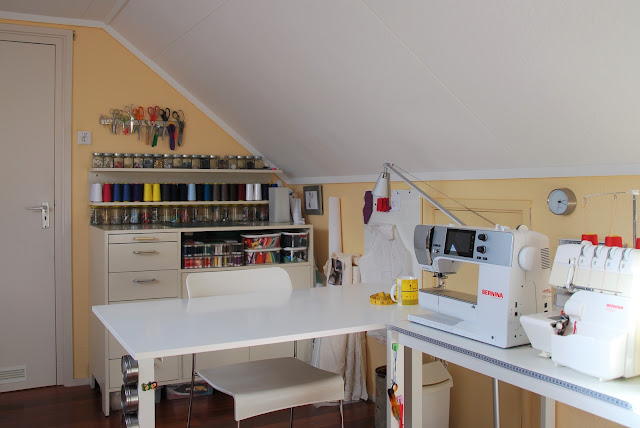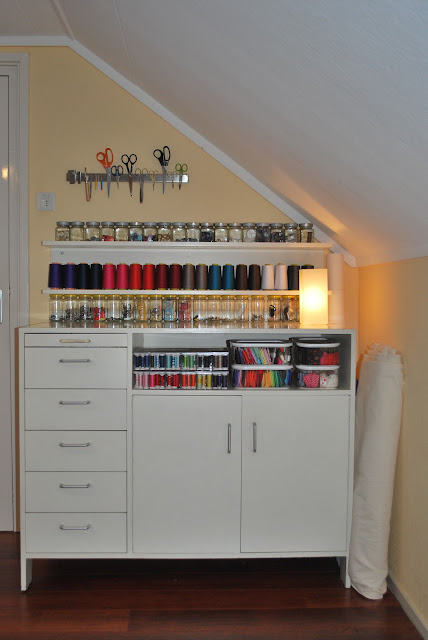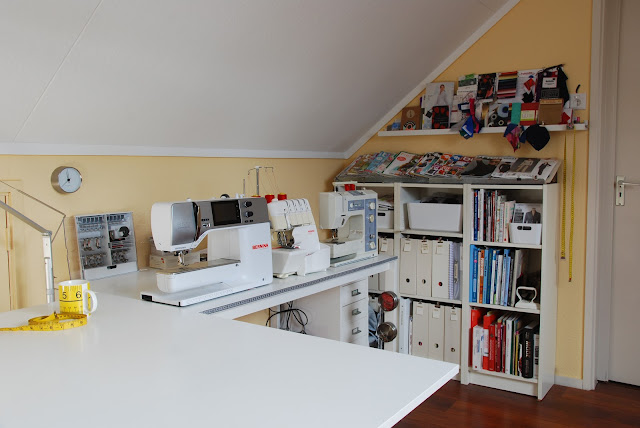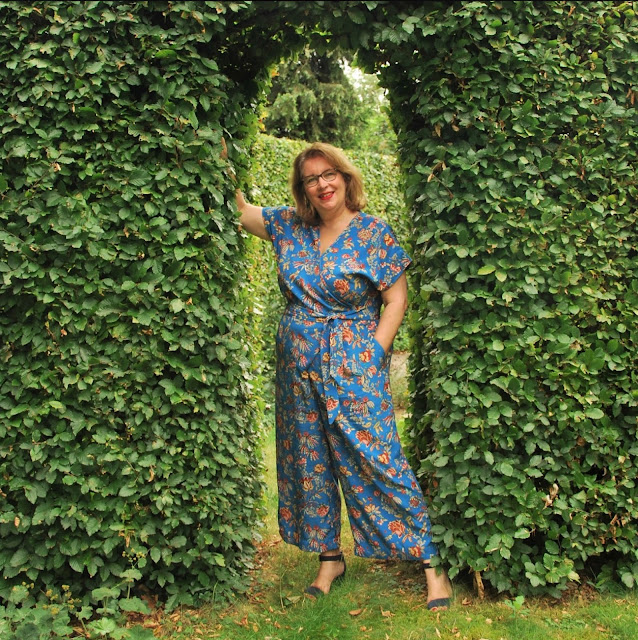This week an article about my sewing room was posted on the Bernina Benelux blog It's in Dutch, and since Google Translate has the habit of throwing all kinds of oddities in the mix when translating sewing terminology, I thought it would be a good idea to share an English version on my blog.
So here it is, a long overdue post with snippets of what I've been up to recently.
Hi! I’m Marianne, born in 1957 and dressmaker since 1977. It started with hippie dresses during my days at Uni, followed by power suits and a wedding dress in the 80s, baby clothes, children's wardrobes and later prom dresses for my daughters. Each phase presented new creative challenges. Now I mainly sew for myself again. My favourites? Beautiful, challenging patterns with elaborate details. It's wonderful to see the image you have in your head slowly become reality! These days I mainly post my works in progress and finished garments on Instagram (@foxglovesandthimbles)

For years, the kitchen table was my workplace. My sewing machine was in the china cabinet, the fabrics and haberdashery were in the attic. When I set up a dedicated sewing room as an empty nester, it was my priority to store everything as organised as possible. My sewing room is under the sloping roof, there is no room for tall cabinets. The most important piece of furniture is an old baby dresser, made by my father during my first pregnancy. That baby dresser is packed with fabrics and haberdashery. Both in the open compartments and on top yarn, ribbons, buttons. On the wall above hangs a magnetic strip for storing scissors and other tools. It's incredible how much you can store on a surface measuring just 60 x 120 cm!

Across the room there are three low bookcases filled with patterns, pattern magazines and sewing books. Shoe shelves are mounted on top so I can display the latest magazines and patterns. Under the shoe shelves there is storage space for rulers and tracing paper, above the bookcases there's a picture shelf with a few magnetic boards for inspiration pictures and fabric swatches.
I have two tables in a L-shaped set up. A standard table for the machines, a sit/stand desk for hand sewing, pinning and basting. By using a hand crank that table easily changes to cutting table height for tracing, pattern drafting or cutting fabrics. Magnetic storage boxes and hooks for small tools hang from the metal legs. An old keyboard tray is mounted under the top. Perfect for having everything within reach and still keeping your worktop empty.
All furniture is kept white, to create a neutral backdrop. Older elements have been added here and there, such as my grandmother's sewing box, vintage sewing magazines from the year I was born and the painted thread spools I played with as a child.
I have three machines. A Bernina 570 QE, a Bernina 1100D overlocker and a Bernina 1030. For the first ten years of my sewing career (including the wedding dress!) I worked with a heavy, noisy machine found next to a garbage bin. It was blessed with the subtlety of a bulldozer. Buying my first Bernina made such a huge difference that I was sold on the brand for life. A favourite? I once said that in the event of a fire, I would run to save the 1030 first. After all, it's my first love. But I wouldn't miss the other two for the world!
What does your dream sewing room look like?
My dream sewing room is a room where everything has a fixed place and you can find things with your eyes closed. The size of that room is less important, the organization level all the more. For me, the trick is to find (and keep) a good balance between the available space and the amount of stuff you drag into it. It's an ongoing battle to ensure that the doors of the fabric cabinet can still close and the number of patterns remains within limits. Sometimes tough choices have to be made in order to keep my room free of clutter and prevent overflowing drawers. But creating my dream workspace is worth it!
Big projects or quick projects?
Big and captivating please! During the first lockdown I found distraction in making a winter coat. Tailored, using horsehair canvas, a pad stitched collar, bound buttonholes. The kind of project I find it hard to walk away from once the last stitch is made.
During the next lockdown I worked on a Chanel-style jacket, made with traditional couture techniques. Quilting loosely woven bouclé and silk, using the Bernina walking foot #50. I spent a total of 124 hours on this jacket and loved every minute of it.

Do you mostly sew during the day or at night?
That depends on the season. During summer I spend a lot of time gardening in the cutting garden and mostly sew on rainy days. I often get the best ideas in the middle of the night. Because sewing projects also come along in my sleep!
How many garments have you made?
Uhmm, countless? My wardrobe is 90% handmade. I make what I need, from t-shirts and jeans for working in the garden to evening wear and everything in between. Never a dull moment!
Is your sewing room chaotic or always tidy?
Don't be fooled by the pictures! When I'm busy it always becomes a disaster area with me slaloming between the piles. But as soon as I finish a project, I put everything back where it belongs and clean the room. And then there's that magical moment, sitting at a completely empty sewing table. Time for the next plan!
—————————————————————————————————————————-










